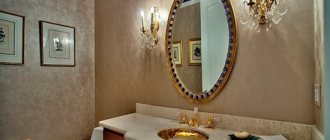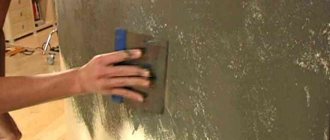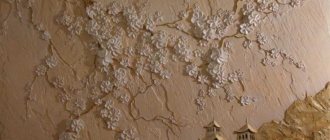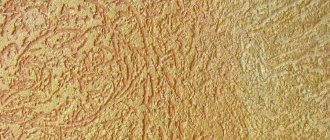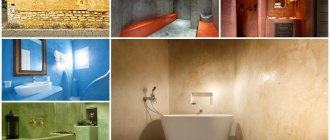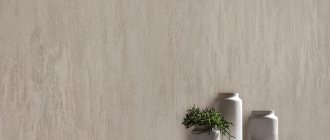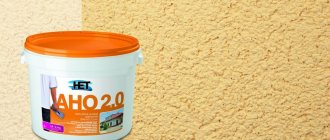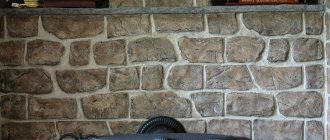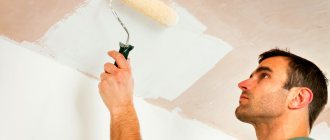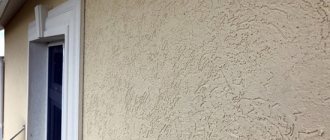Features of Venetian plaster
Venetian is suitable for decorating premises of any complexity. The use of the material allows you to create various visual effects. The introduction of additives into the composition increases its strength and performance characteristics.
Marble plaster is used to treat any type of wall. Its distinctive feature is the presence of crushed stone (onyx, quartz, granite, malachite). Additionally, slaked lime, moisture-resistant components, and pigment are added.
Using Venetian plaster that imitates marble, you can create a luxurious interior
Modern manufacturers offer a large selection of formulations. They are supplied in the form of a mastic or powder that requires dilution.
The color range is also presented in a wide range. The base color is white. If the palette does not have the required shade, it is obtained by tinting.
Advantages of Venetian plaster
Venitian marble is characterized by many advantages:
- The material is environmentally friendly and safe. You can use the Venetian in children's rooms;
- presence of many shades. Each person can choose the color that he likes best. The lighter the shade, the more noble the room becomes. Often people use a golden or colorless shade of Venetian plaster;
- the material is resistant to mechanical stress. It is difficult to damage plaster applied in several layers if all the rules are followed;
- the plaster is reliably protected from the effects of atmospheric phenomena. The material can withstand rain, sun rays, snow;
- the Venetian is light and practical to use;
- can be simply processed;
- the plaster is resistant to low temperatures and ultraviolet rays;
- ease of care. The plaster can be cleaned of dirt by wiping it with a napkin. It should be dry or slightly damp. If the walls are heavily soiled, you can clean the areas with a soap solution;
- lack of joints;
- cheap compared to natural marble.
Venetian marble is smooth. The material is applied in 3-4 layers. This helps make the drawing deep and attractive. Each layer must dry, and then the next one is applied. This will help avoid problems in the future. The surface will be uniform and smooth.
For naturalness and versatility of work, experts recommend applying several layers during finishing work. This will make the walls presentable and solid, and the entire room will become original and unique.
Advantages and disadvantages
Venetian belongs to the category of complex coatings.
Not all masters are able to reproduce it. This fact does not reduce its prevalence and frequency of use in finishing. The technique has earned its popularity due to its undeniable advantages:
- environmental safety;
- original effects due to reflection and refraction of sunlight;
- excellent performance characteristics;
- fire resistance;
- varied color palette;
- ease of cleaning;
- resistance to moisture and temperature changes;
- long service life;
- possibility of restoration.
Wall finishing options
Venetian plaster is the general name for a whole group of solutions and the method of their application. Experts distinguish several of its subtypes, depending on the method and sequence of laying layers, the final result and the composition of the mixture.
Craquelure
Craquelure is a technique that imitates antiquity. When reproducing it, a natural color scheme (beige, brown, yellow, white) of pastel tones is used. Fancy patterns are painted on the walls, repeating the lines of natural cracks. An additional effect is obtained through the use of craquelure varnish. Once dry, it pulls the plaster together and creates fractures.
Decorative craquelure plaster has fancy patterns with cracks
Carrara marble
The technique of reproducing Carrara is to create many translucent coatings that differ from each other by half a tone. White is used as a base. The mixture is applied to it, each time changing the shade by half a tone. The recommended number of approaches is 5 or more.
The more coatings are made, the more interesting and rich the finish looks. The color transition is chosen either from light to dark, or from dark to light.
To achieve an imitation of Carrara marble, several translucent layers of different tones are applied
Trevignano
Trevignano is a separate type of synthetic plaster that allows you to create a pattern that imitates polished marble. The material is characterized by high plasticity, ease of application, and high drying speed.
The use of thin layers of different shades allows you to create walls with internal depth and original tints. During operation, it is important to maintain the thickness of the application. Each coating is made no more than 1 millimeter, it should be translucent.
Venetian Trevignano plaster creates the effect of polished natural marble
Marseille wax
Marseille wax is a coating that imitates old stone walls. It is distinguished by its relief and unique patterns. Due to the use of several shades, it allows you to reliably reproduce the texture of real stone. The technique is used to decorate not only interior spaces, but also the facades of buildings, terraces, and swimming pools.
The coating is obtained by adding special wax to the solution. It adds chic to the interior and improves the technical characteristics of the material.
Marseille wax coating allows you to create a relief that imitates old stone walls
Veneto
Veneto is a finish that replicates matte polished marble. It is used in the design of living rooms, hallways and other classical-style rooms. Allows the use of various shades. A distinctive feature is the matte surface. It is obtained by applying synthetic wax.
Veneto coating is a semi-matte surface with the effect of polished marble
Marbello
Marbello is a special type of mortar that allows you to recreate the texture of rough marble with fascinating shiny veins. This material adds luxury to any interior. A distinctive feature is the ability of the finish to change its shade under different lighting angles. Marbello is not only the luxury of shabby marble, but also a pleasant velvet surface. Such compositions have found their application in the design of living rooms, halls, halls and other common areas.
The exquisite texture of Marbello is similar to velvet with streaks of gloss
Encausto
Encausto is a decorative plaster containing marble powder and acrylic-vinyl resins. The solution is supplied in ready-made paste form. Found application in various interior styles: from minimalism to classicism.
Encausto reproduces the surface of polished granite with the smallest terracotta inclusions and a slight matte sheen. The surface is smooth, translucent with a dark tint.
Using Encausto coating, it is possible to recreate a dark matte surface reminiscent of granite
Marble
In modern interior design, decorative marble plaster is used quite often. The name of this material speaks for itself (it contains marble chips). However, other mineral binders and water-repellent elements are also present here. But it is Venetian plaster (marble) that makes the material what it is - luxurious and original!
There is also acrylic Venetian plaster . It is easy to apply and differs only in the binding component.
If you decide to use this type of plaster for indoor walls, you should consider different design options.
The main advantages of using decorative marble plaster
Venetian plaster (as marble plaster is often called) has many advantages. Among them it is worth highlighting:
- maximum resistance to minor mechanical damage;
- a large number of color shades, which allows you to choose the option that best suits your preferences;
- vapor permeability, which allows the walls to “breathe”;
- resistance to various climatic conditions. This factor is very relevant if the finishing material will be used for outdoor use. The coating is not afraid of heat, rain, or snow;
- complete environmental safety of the material.
Scope of application of marble plaster
Venetian plaster marble can be used for both exterior and interior decoration of a home. The main thing is to apply it as a final wall covering. This will allow the walls to stand out against the general background!
Venetian marbled plaster best suited for finishing non-residential buildings. This could be an office space, an administrative building, etc. However, you can also use it for your home interior. After all, a lot here depends on which particular version of plaster will be chosen (its texture, color, shine).
Features of using marble plaster
Remember that Venetian plaster must be applied to a perfectly flat and dry surface that does not contain cracks or any other defects. For application you need:
- spatula or stainless steel trowel;
- grater - mat (if necessary);
- roller and sponge for applying a protective composition;
Before applying dry plaster, it is worth preparing the mixture. Decorative relief plaster is placed in a container, where filtered water is added and everything is thoroughly mixed until a homogeneous mass is obtained. Only after this can you start applying plaster to the wall. It is important that the application procedure occurs without interruptions, as this may cause joints and unevenness to form on the wall.
What surfaces can be finished with Venetian
The Venetian allows working with various types of surfaces. It holds up well on:
- brick;
- foam block;
- concrete;
- aerated concrete;
- tree;
- drywall.
Venetian plaster can be applied to any surface
The main requirement is preliminary preparation and leveling of the base.
Rules for working with Venetian plaster
Thanks to plaster, it is possible to create an original ornament simulating natural stone. Regardless of the chosen technique, there are basic rules for working with the Venetian:
| The base is the first layer. For it, choose a solution of white color or basic tone. | |
| After drying, the base must be cleaned, eliminating sagging and unevenness. | |
| Subsequent layers are applied using a flexible spatula. The strokes are arched, perpendicular to each other. Thickness no more than 1 millimeter. | |
| Each approach is done after the previous one has dried. | |
| The minimum number of approaches is 3-4. Maximum 12-15. | |
| The effect of natural stone is achieved by using a mass of contrasting color or shade of different intensity. | |
| Polishing with wax completes the job. It protects the surface and gives it a matte or glossy shine. | |
| Soft materials are used for polishing. |
Experts recommend maintaining intervals between applications of at least 12 hours. This is due to the fact that the layer sets within 20-40 minutes, and you can touch it after at least 6 hours.
Application of Venetian plaster in two tones
This application technique is more complex, requiring not one, but two tones. The technique will be different from the previous one. The work is carried out with one color, which differ from each other by a couple of tones.
Step 1.
Prepare the required amount of two types of plaster in advance. But use different tones in separate containers. Determine the area where the work will be carried out.
Step 2.
As mentioned above, apply in a circular motion with the first light-colored plaster. Apply with slight pressure without removing excess with a spatula.
Step 3.
Wait for the first layer to dry. And only after this should you start applying the second one. This layer will serve as a textured part of the finish. Immediately form veins of different sizes in a chaotic manner. Then you should apply a small amount of dark tone to the layer of plaster, forming some elements. The effect of a real stone will be created. Don't draw your drawings too carefully. Do it easily in a chaotic manner. The design will be unique and the finish will be unique.
Step 4.
Then a third layer of light plaster should be applied. Use extra force during the process. Apply in semi-circular movements. Then the areas are polished and excess is removed. The process is similar to that used for the classical technique.
Step 5.
Wait for the new layer to dry. Next, treat the application surface with a sponge.
Step 6.
Remove dust from the surface and treat the area with wax. After drying, wipe with a dry cloth. Once all these steps are completed, the process can be considered complete.
Important! Before choosing an application technique, evaluate the scale of the surface. On a large wall, applying several tones should look neat. Otherwise the wall will be colorful. For such walls, a classic monochromatic application is perfect. If you decide to apply this method, then choose tones that are not very different from each other. Otherwise, the result will not look the best.
How to select and prepare material
The choice of material directly depends on the characteristics of the design project. Experts recommend adhering to a number of rules when selecting materials:
- The mixture is purchased at trusted outlets or specialized stores.
- The type of solution is chosen depending on the design of the room and the desired result.
- When purchasing, carefully study the expiration date, storage conditions and integrity of the packaging. It is unacceptable to use expired formulations or solutions with opened containers.
- The soil is selected depending on the type of plaster.
Tools for work
Any surface finishing requires the preparation of tools and materials. It is important to calculate the weight of the plaster in advance and purchase the required number of cans. Tools are cleaned and placed within walking distance.
To work you will need:
- plaster;
- deep penetration soil;
- colors;
- water;
- spatula;
- brushes;
- roller;
- tray;
- container for mortar (there is a dry plaster mixture);
- rubber spatula;
- Sander;
- soft sandpaper or mitt for grouting.
You may also need a cloth to clean your hands and tools.
Tools and materials for applying Venetian plaster
Roman invention.
Despite its name, it does not come from Venice at all.
It was invented in Ancient Rome. There, someone came up with the idea of using the crumbs and dust that remained after sawing marble. And it owes its second birth to Venice several centuries later - during the Renaissance. In Italian, this finishing method is called “stucco veneziano” or “marmorino”. It was used as an independent covering for walls, and also as a base on which frescoes and paintings were applied. Various types of Venetian plaster were used. In Venice, which is located on the water, in some buildings such coating has survived more than one century, which proves its unique durability. Applying Venetian plaster was already an art then. As the Venetians once found out, painting holds up very well on such “artificial” marble. The colors remain fresh for many decades. In this regard, it probably has no competitors.
Many artists of the Middle Ages used such plaster as a canvas for their works.
Another advantage that the Venetian has is that it has no joints. It can be used on walls of any shape. In addition, it is cheaper than natural marble.
Due to its many advantages, Venetian plaster wall decoration has remained one of the most popular types of coating for centuries.
Surface preparation
Surface preparation is the first and most important step. It contains several required steps:
| 1.The walls are carefully inspected, assessing their condition and determining the level of difference. If it is more than 2-3 millimeters per square meter of area, then they need to be leveled. Local bulges are cut off with a grinder. | |
| 2. The surface is cleaned of old coating. Identify weak points. Areas where the layer crumbles are beaten off. | |
| 3. After cleaning, cover with primer. It increases the degree of adhesion of the material to the base and binds the smallest dust particles. | |
| 4. If the difference is more than 2-3 centimeters, leveling is done, preferably with reinforcing inserts. If the difference is acceptable, then obvious defects are repaired. | |
| 5. The surface is covered with a layer of putty. | |
| 6. The final stage is cleaning, sanding and priming the base. |
In order for the final coating to be of high quality, it is necessary to carefully approach the preparation stage and level the working plane as much as possible.
An alternative preparation option is to install plasterboard partitions. They provide a foundation of sufficient quality.
Application technique
Application of Venetian plaster is possible only after completion of the preparatory work. They are a mandatory step if it is necessary to obtain a high-quality surface. An important point is the calculation of the required amount of material. It is done before finishing begins. It will be unpleasant if at the most crucial moment the color or Venetian runs out.
Before starting work, you should calculate the required amount of material
The application technique consists of several stages. It includes:
- preparing the solution;
- creation of a database;
- subsequent application;
- polishing
Venetian plaster is a multi-layer finishing method. The more layers created, the more interesting the final result looks.
Base layer
Already at the initial stage you need to imagine what kind of wall you will get in the end. This allows you to select the right colors and apply the solution in the right direction. The base layer of Venetian plaster is a leveling layer. A base shade is chosen for it. In some cases it may be white. The material is applied using the classical technique:
The solution sets quickly, so all actions are carried out quickly and confidently.
The purpose of the base is to level the surface and create gloss for subsequent application of the design. You can begin subsequent work only after the solution has dried.
Classic multi-layer marble effect method
The classic method of applying Venetian plaster with a marble effect involves 2 or more coatings. The more there are, the more interesting the drawing turns out. The use of a solution of various shades also allows you to achieve a natural texture. They are obtained using different colors or one, but changing the intensity.
Using solutions of different shades, you can get a natural coating texture
Venetian dries from 6 to 12 hours. However, experts recommend applying layers at intervals of at least 24 hours. This guarantees a high-quality result.
How to apply layers correctly
The quality of the coating directly depends on the number of overlaps. The more there are, the more interesting the finished surface is. It is important that each subsequent application is thinner than the previous one, no more than 1-2 millimeters. The finishing layer is made almost transparent. When creating a Venetian, it is important to follow a number of rules:
- Each subsequent layer is applied after the previous one has dried.
- The application thickness does not exceed 1-1.5 millimeters. The thinner the better.
- The solution is applied to a wide spatula; the tool is held at an angle of 30 degrees during application.
- Strokes are made perpendicular to each other.
- The work goes better if the direction of movement is from a dry surface to a wet one.
- After the solution has dried, it is treated with the corner of a spatula, creating thin small veins.
Each subsequent layer of plaster is applied after the previous one has completely dried.
Don't worry if gaps appear during the process and the previous color becomes visible. It is important that this corresponds to the overall idea of the drawing.
Working with multiple colors
You can get an original pattern by mixing several colors. In most cases it is one color. But it is applied with different intensities, and then mixed during the installation process. Working with different colors can be done in two ways:
- Layer-by-layer color replacement. The base is made in a darker shade. To apply subsequent coatings, color is added, making a mass of different intensities. During plastering, light and dark shades alternate.
- Simultaneous application. Working with two shades at the same time is more difficult. To do this, you need to distribute the mass into two containers. Pigment is added to each, but with different intensities. One container should turn out lighter, the other darker. The master uses both solutions. It is important that the strokes are applied overlapping first one, then another shade. The movements are chaotic, characteristic of classical technology.
When applied simultaneously, work with two shades of varying degrees of intensity
The first layer involves drawing larger details of the picture. Multi-colored strokes make them larger, brighter, and there is less mixing. Subsequent application allows you to smooth out errors, even out the tone, and draw a picture.
Marbled drawing of a Venetian woman
The most expensive interiors are distinguished by detailed drawing of details. They involve the creation of cracks, inclusions and other features of natural stone. This technique allows you to highlight the advantages of the material and add elegance to the interior. Drawing is carried out only at the final stage, after the surface is leveled and sanded. For work, spatulas and thin brushes are used. A darker base color, in some cases black, is used as a pigment. It is diluted with water.
Veins are painted with thin and thick brushes
For specks, use rounded brushes of larger diameter. For veins - thin, for large faults - thick.
This stage allows you to show creative imagination and requires artistic skills.
Working with the finishing layer
The creation of the Venetian is completed by working with the finishing coating. It is produced after the layers have dried and the pattern has been applied. Processing the finishing layer of the Venetian involves stripping and sanding. The result is a perfectly flat plane. In some cases, ironing is used. It allows you to achieve a mirror effect.
Gloss, velvet, relief...
Today this finishing method is still in demand. It is used in three main versions: glossy, embossed and semi-glossy. Among the classic varieties are different types of Venetian plaster.
- One looks like polished marble, is extremely easy to apply, and is coated with wax on top.
- The second one replicates the texture of marble very well: the coating is translucent. It is similar to the travertine rock - stalactites in underground caves are “made” from it. This look looks luxurious and fits harmoniously into classic, vintage interiors and goes well with the Baroque style. This Venetian marbled plaster is one of the most common solutions in modern interiors.
- There is a velvety one, on the surface of which glossy veins are scattered. It is suitable for rooms where there is high humidity.
- Another variety has a semi-matte surface with dark inclusions. Looks like granite. Covered with wax.
- Golden translucent plaster contains gold dye. This creates a feeling of radiant luxury.
In the manufacture of these types of decorative coatings, wax of different compositions is used. Each type has its own specific features: the application of Venetian plaster in each case has its own specifics.
To make the surface matte, it is covered with a thin layer of wax and simply allowed to absorb.
Gloss is obtained using another type of wax. It is leveled using a special spatula and then rubbed in with force. Friction gives an interesting effect - the top layer polymerizes - this is what gives the shine. In any case, finishing with Venetian plaster is a very interesting solution. It looks very modern, despite the venerable age of this technology.
And sometimes the composition is in no way inferior to expensive imported mixtures. In this case, the Venetian will cost much less, and the consumption per m2 will be different.
Application of protective coating
Additionally, the plaster can be protected from water, sun and other negative factors by applying a special coating – wax. It is made on a synthetic or natural basis.
Rubber spatulas are used for work. They allow you to apply the thinnest coating and do not scratch the walls. After drying, the plaster is sanded with a machine.
After drying, a finishing wax layer is applied to the base using rubber spatulas.
Beeswax polishing
Beeswax is a natural product. Its use gives the walls a special gloss. The material is applied with a soft rubber spatula in small volumes. It is important to cover all the walls. The wax should be left for half an hour. Then the surface is polished with a grinding machine. It is important that the impregnation does not rub off, but is gently absorbed.
Wax for plaster can be natural or synthetic
Synthetic wax polishing
Polishing with synthetic compounds does not differ in its characteristics from the process with a natural product. Synthetics are used in cases where the result should be matte. It is also necessary to remember that the drying time for synthetic materials is from 10 to 14 days. Only after this period can you wipe and wash the walls.
Application with imitation marble
The last third type of finishing, which is even more complex than the previous one and requires certain experience in working with this type and skills..
Step 1.
Before starting work, you should prepare the plaster of the main color. Do not forget about mixtures of black and white, creating a marble imitation. Apply the first base coat of plaster. During the process, the plaster should be applied from right to left, creating the stripes that are characteristic of marble.
Step 2.
Wait for the layer to dry. Only after this, take a large amount of the base shade on a spatula, apply it to the desired surface, and add white color to it. Mix these two colors. Then add black.
Step 3.
Repeat applying all colors of the mixture. Try to apply the mixture diagonally, moving from top to bottom, creating stripes.
Step 4.
Using the previous technique, continue until complete. Wait for it to dry.
Step 5.
An important step will be to treat the application area with fine-grain sandpaper. Remove any remaining dust from work.
Step 6.
Apply wax using a spatula. It will perform the function of protection and make the surface glossy.
Step 7
After waiting for it to dry, wipe the application area with a dry cloth.
After reading this article, you became aware of three types of plaster application. Despite the hard work, you will be pleased with the results. Try each finish as soon as possible. And then, choose your favorite one.
If you can't decide which method to use, look at photos of different results before starting. Perhaps some works will inspire you. Plaster finishing is a creative process. After all, you create the drawing yourself.
The cost will depend on several factors. Sometimes finishing with decorative plaster will cost less than ordinary plaster with subsequent wallpapering.
Create a polished marble effect
Venetian plaster allows for a variety of techniques. One of the interesting ones is polished marble. Its difference is its ability to refract and reflect the sun's rays. Such interiors turn out lighter, more voluminous, and filled with air. Polished marble is widely used in the classic design of country houses:
- For plastering, use a spatula with rounded edges.
- The working mass is applied with vertical movements, with different pressure and direction.
- The classical technique involves 3 or more approaches to create the desired pattern.
- The walls are dried for a week. After this, beeswax is applied. It is responsible for the glossy effect.
- Polish with a suede mitten. It is put on the hand. The movements are made in a circular, smooth manner, with light pressure.
It is recommended to apply Venetian plaster using a spatula with rounded edges.
Venetian plaster treated with beeswax has a special gloss.
Mixture composition
Marbled Venetian consists of fine marble chips with the addition of dust, quartz, and granite. Particles of other stones are also added. The coating can be effective if you add the smallest parts of the stone. They help make the surface noble and beautiful.
The Venetian was used back in Ancient Greece. Rich people decorated their houses. Such decor helped make homes more beautiful and comfortable.
In the Middle Ages, slaked lime with the required amount of water was added to stone chips and dust. To give the material the desired shade, juice squeezed from plants was added. Animal blood and a large number of natural dyes were also used. The prepared composition resembled thick sour cream. Real beeswax was used to protect the finished coating. Venetian plaster is durable. This property appears after applying beeswax. Modern craftsmen also use it, since the color of the Venetian has not changed for more than 50 years.
Modern craftsmen try to use real stone chips and the smallest dust particles when making Venetian plaster walls. To protect the finished material, many synthetic analogues of beeswax are used. The most common polymer is acrylic. But other types of polymer materials were also used.
The Venetian is colored using synthesized dyes to make it look like marble. Color is often used to paint walls. It can be applied under a primer or added to the plaster composition.
Is it possible to make a Venetian from putty?
Experienced craftsmen prefer to make Venetian with their own hands. This is due to the high availability of components and their low basic cost. For preparation you will need:
- acrylic varnish (for example, Tikkurila Paneeli Dali);
- finishing putty (compositions containing marble flour are suitable);
- color.
Preparation progress:
- Diluted varnish is poured into a five-liter bucket. For each liter add 100-150 grams of water.
- Pour putty into the container in a thin stream. For 5 liters there is approximately 2.5 kilograms of powder.
- The ingredients are thoroughly mixed.
- The desired color is obtained by tinting.
The result is a decorative mixture that is resistant to moisture.
How to repaint it a different color
Often, in order to match the designers' ideas, the paste must have a different shade from white. A number of manufacturers already produce tinted compounds, but they do not always meet the requirements. Painting paste allows you to create the desired color. To do this, use a color that is suitable in composition. They are sold in construction stores.
Color is added to the mass in a clearly defined proportion. Changing its volume up or down allows you to get different shades of the same color.
The color is added to the decorative plaster and stirred with a construction mixer.
The pigment is introduced directly into the prepared solution. The composition is stirred with a construction mixer or drill for 5 minutes. The entire mass should become homogeneous.
The color of the walls may become lighter after the solution has completely dried.
Examples in the interior
Venetian is used to create various style solutions:
- Walls. Suitable for classical, minimalism, baroque and other styles. Used to decorate living rooms, halls, and corridors.
- Ceiling. The composition gives the ceiling an original relief and texture.
- Columns, fireplaces, niches. Plaster is used to place color and texture accents on decorative elements.
Venetian plaster is used for finishing walls, ceilings and individual decorative elements in the interior.
When decorating bedrooms and children's rooms, preference is given to classical technology. In the case of living rooms, choose more saturated or basic colors, experiment with patterns, and prefer rich textures.
In the dining room, the material is combined with antibacterial impregnation, which will reliably protect the walls from fungus and mold. In the corridor or hallway, the decoration adds expressive tints, highlights, and matte touches.
No less interesting is the Venetian design of balconies, toilets and bathrooms. The designer’s task is to choose the right color scheme and technique.
Correctly selected Venetian plaster makes a room elegant, delicate or dynamic. It allows you to recreate a stone pattern or create shiny grooves. The peculiarity of the texture directly depends on the experience of the artist, the chosen composition and application technique.
Have you ever applied Venetian plaster? What technique did you use? Share your life hacks in the comments.
Venetian marbled plaster in a residential interior
Venetian marbled plaster is a fairly expensive material, it helps to create luxurious interiors, and with its help the palace style is best realized. Such wall decoration will give any living room a sophisticated look; the marble surface helps create an atmosphere of solemnity.
Most often, this material is used to decorate living rooms or work rooms. In large houses, Venetian marbled plaster is best suited for finishing hallways and reception rooms. The combination of strength and practicality with aesthetics provides excellent results and achieves well-deserved recognition.
Why is marbled plaster called Venetian, although it was first invented in the Ancient World? The answer to this question can be found by looking into history. Marble was indeed used in the construction of numerous palaces in the Roman Empire, but there was a catastrophic shortage of it. And then local craftsmen learned to extract marble chips, mix them with water and decorate the interiors of palaces with the resulting solution.
Then they forgot about the interesting technology. It was revived when the great Raphael painted his canvases. The Italian architect Andrea Palladio accidentally saw in one of his treatises a description of the design of Caesar's palace. Through numerous experiments, he managed to restore the recipe and apply a new coating to decorate his creations. During the Renaissance, marble plaster was used to decorate the palaces and cathedrals of Venice. Hence the name - Venetian plaster.
Modern finishing options created using Venetian marbled plaster are amazing. They are used as the main background, against which stucco or mahogany details look impressive.
Note! The described finish looks more beautiful only in good lighting. Taking this into account, it is worth considering in advance the placement of additional lamps and lighting.
When decorating a ceiling with Venetian plaster to imitate marble, it is best to use glossy coatings. They will help to visually lift the stove and let additional air into the room.

